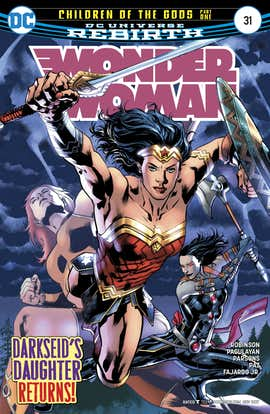
The announcement of James Robinson and Carlo Pagulayan’s run on Wonder Woman was met with a good amount of controversy. Following the acclaimed Greg Rucka/Liam Sharp/Nicola Scott/Bilquis Evely run on the title and the five-issue fill-in by Shea Fontana and Mirka Andolfo, the news that James Robinson would be returning to DC for a story arc all about Diana’s long-lost twin brother seemed to be a return to the overwhelming masculinity of the pre-Rebirth era of Wonder Woman. Unfortunately — with this week’s Wonder Woman #31 — that’s exactly what the title has become again.
RELATED: Wonder Woman: James Robinson Is Building Diana’s Perfect Arch-Nemesis
Everything about Wonder Woman #31 is about men. The majority of the issue follows Hercules who is the most manly man that ever manned, clad in lumberjack gear and capable of felling trees with a single blow of his ax. When we first visit Diana, we don’t greet her as a protagonist, but an object of Steve Trevor’s affections. Her fight against Giganta is viewed through Steve’s eyes, and our opinions of who Wonder Woman is are formed through Steve. Even the villain of the issue, Grail, is working for her father in order to bring him back to full power — so he can presumably be the true big bad of the arc. We haven’t even got to Wonder Woman’s brother Jason yet — who doesn’t debut in this issue — but he’s yet another man for this story to revolve around instead of the title character.
With those criticisms aside, the story Robinson and Pagulayan present is an acceptable-yet-unremarkable superhero tale, as much as it can be when the title character features in 25 percent of the page count. The story follows on from the events of Geoff Johns and Jason Fabok’s “Darkseid War” in the pages of Justice League, and if you enjoyed that story, you’ll absolutely be happy with its follow-up in Wonder Woman. The two stories, more than a year apart, feel extremely complementary in their attempt to tie superhero bombast with the various gods of the DC Universe, both old and new. It’s a good start if you’re a fan of DC Comics as a brand over individuals creators or titles, but as a single unit of comics it’s rather underwhelming.
In fairness, Carlo Pagulayan is the perfect artist for Robinson’s run. A career that has spanned Iron Man, The Incredible Hulk and Fantastic Four has more than proven Pagulayan as a premier artist of superhero comics and superhero stories, and here he ably brings the blockbuster action to Robinson’s underwhelming story. The real star of the issue is Romulo Fajardo Jr., who has been coloring Wonder Woman throughout this volume and provides a level of consistency to the visual language that makes the book immediately recognizable regardless of the creative team.
It’s fine for a title to take a tone shift between creative teams, but Wonder Woman #31 doesn’t fulfill the promise of DC Rebirth or the potential of the character in a year where she’s more popular than ever. Wonder Woman #31 feels like a Wonder Woman comic for people that don’t read Wonder Woman comics, but like to read DC Comics that are quote-unquote “important” to the larger cosmology and continuity. Ultimately, it’s a disappointing debut on the title for the creative team and a disappointing debut for Wonder Woman fans who have six more months of this story.

